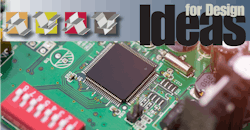Advanced Digital Isolation Technologies Boost Solar Power Inverter Reliability
Today’s photovoltaic (PV) power systems offer a sustainable alternative to fossil-fueled power plants, providing lower long-term operating costs, modular scalability, higher efficiency, and a smaller carbon footprint. These power systems use PV panels to convert sunlight into dc voltage and solar power inverters to transform the dc voltage into ac voltage suitable for a commercial grid.
In addition to performing this essential dc-ac conversion, the solar inverter provides grid-disconnect capabilities to prevent the PV system from powering a disconnected utility. An inverter remaining online during grid disconnect or delivering power through an unreliable connection can cause the PV system to back-feed local utility transformers, creating thousands of volts at the utility pole and endangering both the system and utility workers. Upon reconnect, the inverter cannot deliver power until it detects rated utility voltage and frequency over a five-minute period.
The inverter compensates for environmental conditions that affect power output. PV-panel output voltage and current are susceptible to variations in temperature and light intensity per cell unit area (called “irradiance”). The cell output voltage is inversely proportional to cell temperature, and cell current is directly proportional to irradiance. Wide variations in these parameters cause the optimum inverter voltage/current operating point to move significantly.
The inverter addresses this issue by using closed-loop control to maintain operation at the maximum power point when the product of voltage and current is at its highest value. The inverter also provides manual and automatic input/output disconnect for service operations, EMI/RFI conducted and radiated suppression, and ground fault interruption. Encased in a ruggedized package, the inverter is designed to remain in full-power operation for more than 25 years.
The single-phase PV inverter uses a digital power controller and isolated high-side/low-side gate drivers to pulse-width modulate a high-wattage, full-bridge power stage (Fig. 1). Using feedback from the local ac mains and the power stage, the controller modulates the MOSFETs to synthesize a discrete-time, grid-synchronized 60-Hz high-voltage ac switching pattern. This discrete switching pattern is then filtered to remove high-frequency noise components and delivered to the grid through an isolation transformer.
>A PV inverter’s hardware design is full of tradeoffs that can be problematic if the designer makes the wrong choice. For example, PV systems are expected to operate reliably and at full rated output for at least 25 years, and yet they must be competitively priced, forcing the designer to make tough cost/reliability tradeoffs.
The high efficiency requirements of inverters often require the use of more expensive gate drivers, power switches, and magnetic components. Twenty-five-year system life in an outdoor environment increases the cost of inverter system packaging due to the higher costs of advanced insulation and potting compounds. These considerations and the cost-competitive nature of the inverter market combine to create difficult decisions for the designer.
The PV inverter’s exposure to extreme heat and cold for 25 years should cause the designer to take a major pause when considering inverter components. For example, electrolytic capacitors that filter out ripple, as well as optocouplers that provide galvanic isolation, have no chance of “going the distance” in lifetime longevity. Electrolytic capacitors dry out and fail, and the optocoupler’s LED brightness gradually fades in the face of excessive heat and input current. Workarounds for these delicate components include replacing electrolytic capacitors with costly film capacitors and substituting modern CMOS isolators for the optocouplers.
CMOS technology offers high reliability, cost effectiveness, high-speed operation, small feature size, low operating power, and operating stability over voltage and temperature extremes. Unlike the gallium-arsenide (GaAs) technology used in optocouplers, CMOS devices have no intrinsic wear-out mechanisms. The CMOS isolation cell is capacitive, fully differential, and optimized for tight timing performance, low-power operation, and high immunity to data errors caused by external fields and fast common-mode transients.
The advantages of CMOS, combined with proprietary silicon product design, enable robust isolation devices that offer higher functional integration, superior reliability (greater than 60-year isolation barrier lifetime), –40°C to 125°C continuous operation at maximum VDD, and substantial gains in performance, power efficiency, board-space savings, and overall ease-of-use.
PV-inverter architectures do not end with the single-phase, transformer-based inverter shown in Figure 1. Other common types include high-frequency, bipolar, three-phase, transformerless, and battery-powered inverters. While these topologies vary, they share the need for the same component solutions. The block diagram in Figure 2 shows several CMOS isolation devices used in a transformer-based, three-phase inverter.
In this classic closed-loop architecture, the digital controller modulates the power-switch duty cycle to force the PV system’s output-voltage amplitude and phase to match that of the grid. Individual 2.5-kV isolated gate drivers are typically preferred in inverter designs because they simplify printed-circuit board (PCB) layout.
Current feedback to the controller is provided by a single, CMOS, isolated-ac current sensor that offers a wider temperature range, higher accuracy, and higher reliability than current-sense transformers. The sensor is reset on a cycle-by-cycle basis using the inverter gate-control signals generated by a digital controller, eliminating the need for external reset circuitry.
Like other emerging technologies, PV systems will continue to evolve to meet market demands for higher capacity, lower cost, and higher reliability. As this happens, PV inverters will expand in functionality, and designers will demand more integrated, application-specific component-level devices that will further leverage and drive innovation in CMOS isolation. As these events unfold, PV power systems will become more widespread and ultimately a viable member of the utility mainstream that will significantly reduce our dependence on fossil fuels.
About the Author
Don Alfano
Director of Isolation Products
Don Alfano serves as director of isolation products at Silicon Laboratories and was cofounder and vice president of marketing for Cygnal Integrated Products, which was acquired by Silicon Laboratories in 2003. He has worked for TelCom Semiconductor, NVE, Dallas Semiconductor, and Mostek. He holds a master’s degree in electrical engineering from Villanova University.
